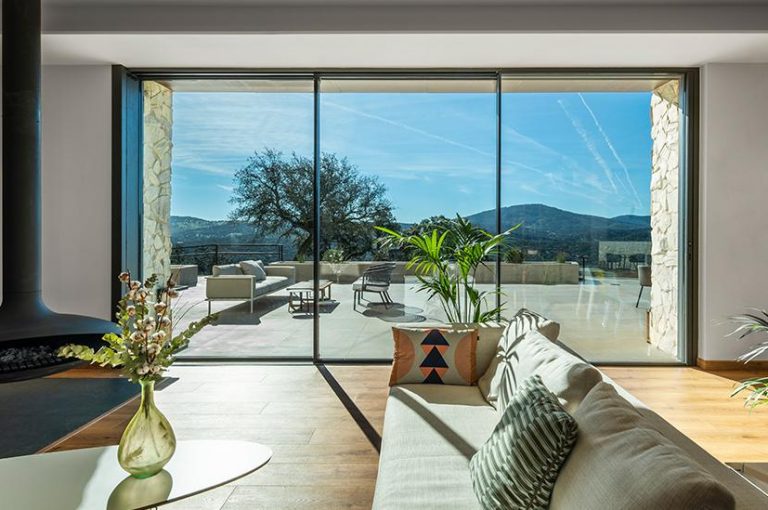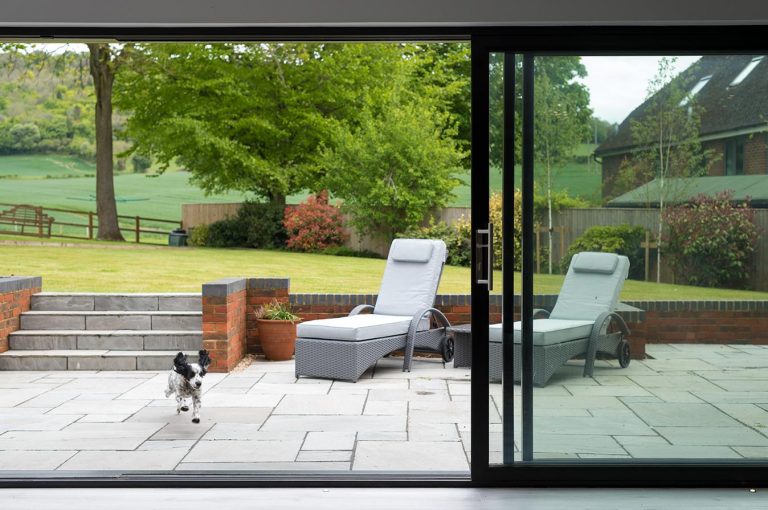A few years ago we started our journey to find the best aluminium sliding doors in the UK.
While conducting our research there were five important qualities which we were looking for, these were:
- The overall quality of the finished product
- Slim sightlines
- Ease of operation
- Thermal performance
- Peace of mind for our 10-year company guarantee & beyond
Our journey began online and took us to numerous sliding door showrooms across the UK where we tried and tested doors from brands such as Sunflex, Cortizo & Origin.
Below are our comparisons between the Sunflex SVG, Cortizo Corvision & Origin OS29 aluminium sliding doors.
The overall quality of the finished product
To be assured of our decision we needed to know where the doors were being fabricated and by whom. Both Sunflex & Origin doors are manufactured in-house at one fabrication facility. Several fabricators manufacture Cortizo doors throughout the UK.
Knowing that the products are manufactured in one place, offers us assurance that the quality and attention of detail we expect is mainated & in the event of an issue arising in the future, it can be resolved by one party promptly.
There are also some features and attention to detial of the Sunflex SVG doors that exceeded our expectations. The Sunflex doors fare flush stacking, allowing each panel to stack neatly behind the neighbouring frame. They also offer a range of high-quality door handles which don’t interfere with the view through the glass panels.
Slim sighlines
Slim sightlines are often an important consideration for our customers, therefore achieving the slimmest sightlines is also important to us.
The Sunflex & Cortizo doors offer a slim 20mm sightline. The Origin OS29 achieves a sightline of 29mm, which is only 9mm larger. However, the depth of Origin OS29 is far larger than the Sunflex & Cortizo doors.
This means that the Sunflex & Cortizo doors look slimmer from any angle.
Ease of operation
Aluminium sliding doors on the whole offer a better ease of operation than their uPVC counterparts.
From the doors we have seen and tested, the Sunflex SVG doors lead the way in ease of operation.
They open and glide effortlessly thanks to their stainless steel quad wheel running carriage & stainless steel track. Ensuring the opening operation is smooth and should stand the test of time.
From our knowledge the Origin OS29 uses nylon wheels on the running carriage and an aluminium track. Stainless steel would be a better solution.
As the Cortizo doors are manufactured by a number of different fabricators it isn’t possible to know the running gear and tracks used as it will vary for each fabricator.
Thermal performance
Optimum thermal performance is important to reduce both heating bills and our carbon footprint.
For replacement windows & doors, the whole window/door U-value must not be higher than 1.4 W/m2K. All three systems can achieve the required 1.40 overall door U-value. The Sunflex SVG doors achieve the required 1.40 with a glass centre pane U-value of 1.0. The Cortizo Corvision achieved the required 1.40 with a glass centre pane of 1.0. The Origin OS29 achieve the required 1.40 with a glass centre pane of 0.8.
Therefore the Sunflex & Cortizo doors lead the way in achieving the required U-value and offer the best thermal performance.
Peace of mind for our 10 year company guarantee & beyond
As a business we offer a comprehensive 10-year guarantee, therefore when choosing a product, it’s vitally important that we have confidence the product will offer us complete peace of mind that it will perform with little maintenance for 10 years and beyond.
Both Sunflex & Origin doors are manufactured in-house at one fabrication facility. Several fabricators manufacture Cortizo doors throughout the UK. In the event of an issue arising in the future, we want peace of mind that the issue can be resolved by one party promptly.
The Sunflex SVG sliding doors & Origin OS29 are mainly glazed with internal glazing beads. This means if you ever had to replace the glass in the future it can easily be removed and replaced. With some slim sliding systems like the Cortizo Corvision, the glass is bonded all round to the aluminium. This means that if the glass ever needs to be replaced in the future you would also need to order a new door panel or new set of doors if that panel is no longer available.
Comparng the Sunflex SVG20, Cortizo Corvision & Origin OS29

Sunflex SVG20
-
20mm sightline
-
118mm (double track) and 184mm (triple track)
-
From 1.2 W/m²k (double glazed)
-
3000mm maximum panel width
-
2800mm maximum panel height
-
Water tightness to 300Pa (Class 7a)
-
Air permeability to 600Pa (Class 3)
-
Flush stacking as standard
-
Double or triple track options
-
Optional pocket sliding
-
Optional moveable corner post
-
Always manufactured in one place at the Sunflex manufacturing plant
-
Glass is glazed with internal glazing beads meaning the glass can be easily replaced if required in the future.

Cortizo Corvision
-
20mm sightline
-
116 mm (double track) and 182 mm (triple track)
-
From 1.3 W/m²k (double glazed)
-
2500mm maximum panel width
-
3000mm maximum panel height
-
Water tightness to Class 7a
-
Air permeability to Class 4
-
Staggered stacking (not flush)
-
Double or triple track options
-
Optional pocket sliding
-
Optional moveable corner post
-
Cortizo supply their profile to numerous trade fabricators accross the UK
-
Glass is bonded to the door panel which means the glass & panel would need to be replaced if required in the future.

Origin OS29
-
29mm sightline
-
143mm (double track) and 213mm (triple track)
-
From 1.3 W/m²k (0.7 glass centre pane)
-
2200mm maximum panel width
-
2520mm maximum panel height
-
Water tightness to Class 6a
-
Air permeability to Class 3
-
Staggered stacking (not flush)
-
Double or triple track options
-
No option for pocket sliding
-
No option for moveable corner post
-
Always manufactured in one place at the Origin manufacturing plant.
-
Glass is glazed with internal glazing beads meaning the glass can be easily replaced if required in the future.

